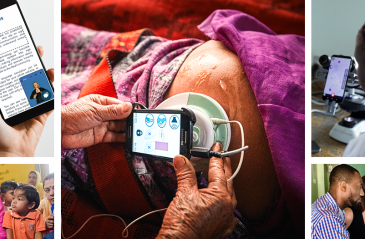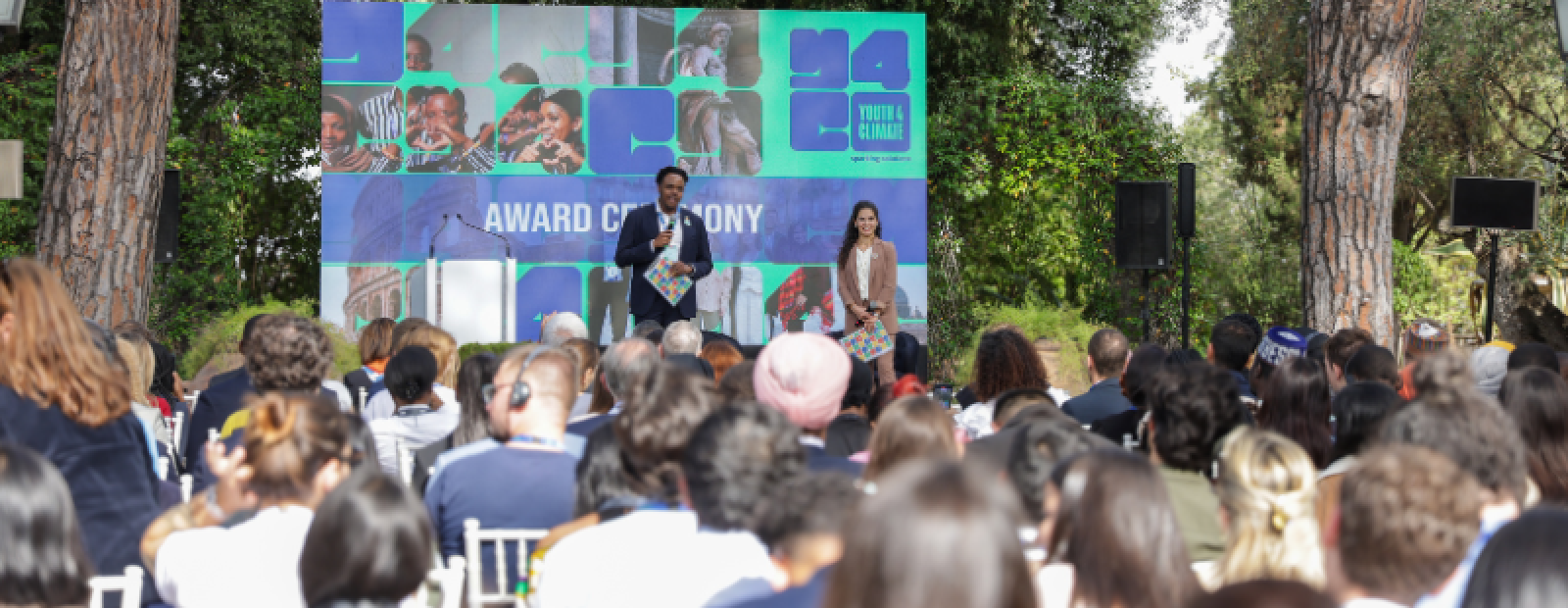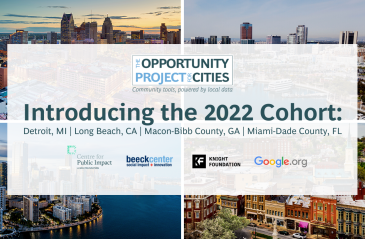

Seven tips for running your next impact challenge
Article highlights
.@CPI_foundation has a long history of supporting philanthropies and funders to run impact challenges, from @Googleorg's Tech for Social Good to @Y4Cofficial. Explore the do's and don't of funding & reviewing impact through challenges!
Share article.@MathFoged & Francesca Livraghi share the advantages and challenges of impact challenges - from democratising grant-making to the importance of long-term support and funding.
Share articleWant to unlock the full potential of impact challenges for a more innovative and collaborative future? Dive into insights from @CPI_foundation on why 'there is no cookie-cutter method for running an impact challenge'.
Share articlePartnering for Learning
We put our vision for government into practice through learning partner projects that align with our values and help reimagine government so that it works for everyone.
Image credits: UNDP Youth4Climate and Connect4Climate.

Identify a problem you want to solve, agree on the prize for its solution, and then spread the word to get the best ideas. When proposals come in, review them against the assessment criteria you’ve laid out, identify the best, and announce the winner. Essentially, that is what an impact challenge is - simple, right?
CPI has a long history of supporting philanthropies and funders to run impact challenges. Although the steps above sound relatively simple, we’ve learned that solving for impact is hard. After running several challenges across topics as diverse as artificial intelligence, climate change, economic opportunity, and cybersecurity, we’ve gathered insights into designing and executing a successful impact challenge. So, continue reading if you’re curious about the do's and don’ts of funding and reviewing impact through a challenge!
What are the advantages of impact challenges?
Democratise grant-making
Impact challenges aim to generate the best ideas by making the call for solutions open to everyone, attempting to foster a level playing field that allows diverse ideas to emerge. In contrast to traditional grant-making, which is largely driven by a funder’s pre-existing ideas and relationships, impact challenges allow any interested parties to apply.
This inclusivity amplifies the potential for impactful change by broadening perspectives and encouraging more diverse and novel thinking for solutions that might be overlooked in traditional grant-making. For example, as part of the Google.org Tech for Social Good Impact Challenge, we witnessed ideas from single entrepreneurs in rural France, to research institutions in Italy, and well-established nonprofits, all proposing innovative ways of using technology for good in their communities.
Spur innovation
Impact challenges can be transformative for complex problems that require diversity of thinking, boldness, and creativity.
For example, Bloomberg Philanthropies’ Global Mayors Challenge focused on accelerating the most ambitious ideas developed by cities in response to the COVID-19 pandemic. The Google.org T4SG Impact Challenge aimed to spur innovative ideas to accelerate economic empowerment, climate action, and combat cyberattacks and disinformation. When the goal is clear but the path is less obvious, an impact challenge can generate unconventional and creative approaches to enduring issues.
Provide connections and exposure for awardees
Aside from the monetary prize, visibility and prestige are huge motivational elements for nonprofits and entrepreneurs to take part in an impact challenge. Typically led by reputable and influential organisations, these challenges give legitimacy to awardees, promoting their work and opening doors to further collaborative partnerships. Whereas traditional grant-making tends to happen behind the scenes due to an impact challenge's open, competitive, and public-facing nature, funders often organise a public award ceremony, offering them visibility to customers and additional funders.
For example, we attended the 2023 Award Ceremony for the Youth4Climate Challenge in Rome, run by the UNDP and the Italian Ministry for Ecological Transition. Young people had the opportunity to pitch their ideas to tackle climate change to an experienced panel in the presence of high-level government officials, with 48 projects awarded 20,000 euros in funding and mentoring support.
Catalyse learning and collaboration
Impact challenges can catalyse communities of practice, carving out spaces for knowledge exchange. And why not? They help lay the groundwork for collaboration among entities working on similar or complementary projects, fostering a nexus of expertise.
For example, the Google.org Tech for Social Good Impact Challenge encouraged applicants to leverage their synergies and complementarities. This resulted in a collaboration between the Free University Guido Carlo (LUISS) and the Italian Federation of Publishers (FIEG) to create an AI-based platform to combat disinformation. Similarly, two Italian universities received a grant to join forces in creating an AI-based application to increase the cybersecurity of small and medium enterprises.
The challenges of impact challenges
So far, so good! But impact challenges are not always as straightforward as they seem. During the design phase, it might be tricky to define funding and scoring criteria without clarity on the actual landscape of potential applicants, especially when the geographical boundaries are wide.
As per operationalisation, the unpredictability around the volume of applications, the involvement of multiple stakeholders in the selection, and the resulting coordination costs demand meticulous planning and a lot of agility in distributing resources.
Participating in an impact challenge also presents hurdles from an applicant's perspective. The challenge model, while effective, may not always guarantee that organisations receive equitable support during the application process.
Language, cultural, and geographical barriers can disadvantage applicants from less connected places. Large funders of impact challenges tend to be based in English-speaking countries, which means that open calls for applications usually require proficiency in English. Cultural differences might also challenge certain applicants in understanding the application process and articulating their ideas effectively. Targeting audiences in underserved geographies and communities and providing diverse ways of communicating guidance and support during the application process is key to equitable participation.
"Targeting audiences in underserved geographies and communities and providing diverse ways of communicating guidance and support during the application process is key to equitable participation."
Here are some things to watch out for when funding through competitive challenges.
Don’t rely too much on impact metrics
Establishing a fair and effective scoring method to evaluate proposals is not easy. Which is better - a website that visualises climate data and emission targets for a country’s municipalities or a mobile app that gamifies waste collection?
While there is often a bias towards measuring impact with quantitative metrics, the thematic areas on which impact challenges focus are often complex, systemic issues such as sustainability, poverty reduction, health and wellbeing. Wouldn't it be reductionist to compare these two apps based on the number of users they reach?
Although numbers can be an interesting indicator, an excessive focus on metrics can lead to overlooking innovative ideas' transformative potential. Awareness of this bias can mitigate the risk of favouring organisations that show immediate, tangible results, compared to those grappling with the root causes of an issue, ultimately aiming at long-term and systemic impact.
Take a holistic and equitable approach to evaluation
Another bias to look out for is the inclination to favour more established organisations that might be better at measuring and communicating their impact over smaller entities that might focus their resources on implementation.
To avoid this risk, the assessment of an applicant should be comprehensive and nuanced. It should, for instance, examine factors beyond organisational size, such as team composition, the origin of their problem definition, and how the team collaborates and learns.
From our perspective, the winners in impact challenges are not necessarily those who shine on paper as “the most impactful”. Instead, they are those who deeply comprehend the problems they seek to address, embrace failure as a pathway to learning, and demonstrate a commitment to collaborate and build relationships with communities across their ecosystems.
Therefore, using comparable metrics in conjunction with a deeper interrogation of the idea's conceptual foundations is critical to mitigate the risk of disproportionately selecting proposals from larger organisations and to award a fair evaluation of different sources.
Long-term support and funding are necessary to sustain impact
To truly get an idea off the ground requires support beyond the prize ceremony. Impact challenges should not just be a flashy way of giving out grants, but designed in a way that addresses systemic issues and works for long-term change.
Hence, funders should not think their job is done after handing over the cheque. Participants require capability-building and support beyond a one-off monetary prize to fully catalyse the potential of their ideas. If funders are serious about sustainable impact, they must commit to providing long-term support or collaborating with other funders to ensure innovations “stick”.
Our experience showed us that some initiatives are moving in this direction by coupling grant funding with technical assistance, while others are explicitly focussing on creating a community of grantees to spark collaborative innovation and long-term engagement.
What does the future hold?
"By implementing thoughtful strategies and considering impact beyond metrics, the full potential of impact challenges can be unlocked, propelling us towards a future defined by innovation, collaboration, and lasting impact."
There is no cookie-cutter method for running an impact challenge. Still, there are ways to think carefully about their design and intentionally address biases and structural inequities that can get in the way of a just outreach and evaluation process.
We hope our experience can encourage funders to adopt a more holistic approach when reviewing proposals and to look more closely at applicants’ capability to learn, collaborate, and tackle systemic issues. This can highlight creative, community-led ideas that might traditionally be excluded. By implementing thoughtful strategies and considering impact beyond metrics, the full potential of impact challenges can be unlocked, propelling us towards a future defined by innovation, collaboration, and lasting impact.
You may also be interested in...


Press Release: Detroit, Long Beach, Macon-Bibb County, and Miami-Dade County work with residents to solve pressing challenges with local data

Systemic funding architecture: A proposition to catalyze urban climate finance


